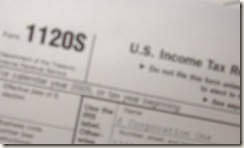 Changing from a C corporation setup to the S corporation setup can be beneficial, but there are numerous factors to consider. With the March 15, 2012 deadline for 2011 fast approaching, you should seek guidance for your situation.
Changing from a C corporation setup to the S corporation setup can be beneficial, but there are numerous factors to consider. With the March 15, 2012 deadline for 2011 fast approaching, you should seek guidance for your situation.
Basic benefits of a switch: If a C Corporation owner elects S corp status, the corporation’s income and deduction items are passed through to the owner, reported on his or her 1040 and taxed at personal rates. Significantly, switching to S status would avoid any threat of double taxation on: (1) future corporate operating profits and (2) future appreciation in corporate assets that occurs after the switch.
As you may know, double taxation occurs when a C corporation pays corporate-level tax on its income and gains. Then the owner pays tax again at the shareholder level when those income and gains are distributed as taxable dividends.
In contrast, a business owner is only taxed once under the S corp form of doing business, while retaining other benefits such as corporate protection from personal liability.
Basic drawbacks to a switch: The decision to switch isn’t always a slam-dunk. If the owner has substantial income from other sources or if the company is quite profitable, he or she may be forced to pay the 35% maximum rate on most or all of the incremental income passed through. Rule of thumb: With the current tax brackets in effect, the owner often fares better if the company generates annual profits of less than $100,000.
In addition, beware of the onerous "built-in gains" (BIG) tax. It comes into play if the corporation owns appreciated assets when it switches from C to S status. When this corporate-level tax applies, the rate is 35%.
We can help you with this determination. Email me at mailto:Vince@MyTexasCPA.com to discuss your situation.
No comments:
Post a Comment